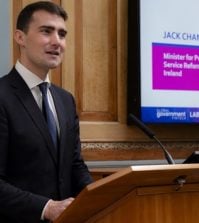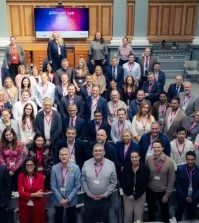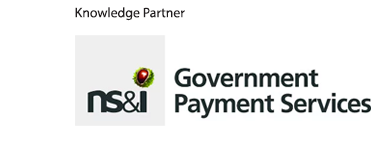The one-two punch: protecting living standards in an era of conflict and inflation

At the Global Government Summit in Singapore, civil service leaders from 16 countries met to explore five of the biggest challenges facing their countries – debating first how to protect living standards. Here we present some of the contributions by the chief economist of Ireland’s Department of Finance
“My minister refers to this graph as one of the most important charts in modern-day economics,” said John McCarthy. Speaking in the Global Government Summit’s first session, the chief economist at Ireland’s Department of Finance was highlighting the steep decline in the proportion of national income captured by labour: in both the EU and US, this figure has fallen from about 70% to 60% over the last 50 years – as the share taken by capital rises ever higher.
“Globalisation is undoubtedly positive: it’s taken one in five people the world over out of poverty,” said McCarthy. “But undoubtedly, there are side-effects – and one of those relates to inequality. The development of transnational corporations has allowed companies to exploit comparative advantage, locating production in different parts of the global economy to enable greater specialisation and productivity. And productivity is good; but the problem that many people have identified is that the gains from greater productivity have been captured by capital rather than labour.”

McCarthy’s second graph, the “elephant curve”, showed that while many emerging economies have seen the rapid rise of a middle class, there’s been a “relative decline of the middle class in many advanced economies”. And while middle earners have seen their real wealth levels flatlining, he added, “you see massive gains in wealth for the top 1 or 2%”.
Absorbing shock
When global economic growth was fairly robust and inflation low, these systemic stresses didn’t present an immediate problem for most families; but following the 2008 financial crisis, the situation became ever more unstable. From 2009, trade as a proportion of GDP – having shot up from 25% to 60% over the previous 30 years – stopped rising, while economic growth shrivelled across the developed world.

Then came the pandemic, requiring huge government spending: Ireland “mobilised about 12% of national income to support lives, to support livelihoods, and to prevent scarring of the economy,” recalled McCarthy. And a week after Ireland lifted COVID-19 movement restrictions, “we had the outbreak of war on European soil, so we had a one, two punch to the economy”. With energy prices spiralling, Ireland saw its first fall in disposable income since its joint sovereign and banking debt crises more than a decade ago. The fall was smaller this time, though, because “government absorbed quite a bit of the shock to households” – spending 4% of national income on targeted measures designed to protect the poorest in society.
Ireland’s economy is now growing quickly again. “We think these supports have generally worked; they have facilitated a rapid rebound in the economy,” said McCarthy. Ireland is, however – like countries around the world – now caught uncomfortably between high public debt, rising interest rates, tight labour markets and high inflation.
Meanwhile, the country faces demographic and infrastructural challenges. High immigration – which has seen the population grow by 11% in a decade – has kept labour markets moving, but puts pressure on public services and housing stocks: housebuilding rates must increase by well over 50%, McCarthy believes. Meanwhile, the country’s population will age rapidly over the coming years; so government will need ever greater sums to fund health, care and pensions.
Ways forward
For McCarthy, the route out of these problems lies in investment – particularly in skills. “There’s lots of uncertainty over what the new normal might be,” he said. “Budget constraints are more binding now than they were this time last year. For many countries, supply is the constraint: boosting supply will be the key to maintaining living standards. And investing in human capital is absolutely key.”
Since 2015, Ireland has raised public sector capital investment from 2.5% to 4.5% of national income. To get full value from this spending, noted McCarthy, the country needs the right workforce: “If we don’t have the workers, all of this additional money is going to go on higher wages.” Hence the government’s focus on raising education levels; among 25-34-year-olds, Ireland has one of the most highly educated populations in Europe.
“In a rapidly changing global economy where comparative advantage is shifting over time, human capital is absolutely crucial,” McCarthy concluded. And this approach has another advantage: governments may have little control over the supply and price of borrowing, energy, commodities and property, but the lever of skills at least does lie within their reach.
Ireland’s economic and demographic troubles are far from unique: civil service leaders have much to learn from one another on how to tackle the problems they face in common. Over the following day, the top officials gathered in Singapore would debate those issues, exploring the new capabilities required of government; the newly potent topic of public health; the sudden rise of AI; and the urgent mission of restoring public trust in government. Look out for our reports on those sessions, which will be published over the coming weeks.
The Global Government Summit is a private event, providing a safe space at which civil service leaders can debate the challenges they face in common. We publish these reports to share some of their thinking with our readers, this year focusing in each report on the main messages of one or more contributors. Note that, to ensure that participants feel able to speak freely at the Summit, we give all those quoted the right to anonymise or edit their comments before publication.
This is the first of five reports, covering the first session. The report on the second session comprises the views of two Summit participants on leadership and delivery in the post-pandemic world, with a focus on data-driven decisions; the third looked at the lessons from COVID on public health and preparedness; the fourth at artificial intelligence; and the fifth at building public trust in government.























